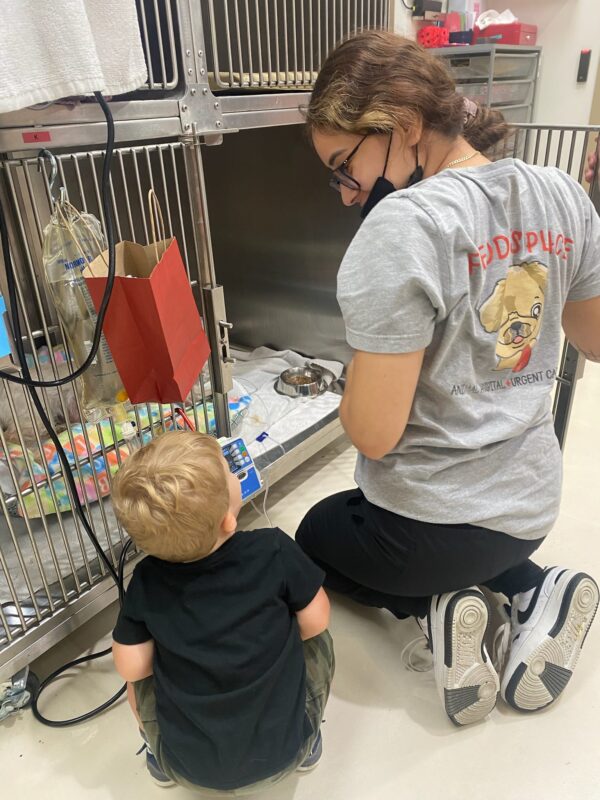Celebrating World Veterinary Day
There are over 600,000 veterinarians in the world, over 125,000 in our country alone. The need is growing for trained and qualified doctors of veterinary medicine around the globe, as animals (mainly dogs and cats) change status from “just a pet” to a celebrated and pampered “family member”. The last Saturday in April (this year on 4/27/24) has been deemed “World Veterinary Day” to heighten awareness to this important profession, and to celebrate the men and women who devote their lives to helping animals with health and wellness concerns. So, be sure to take a moment to thank your primary care veterinarian, veterinary specialist, or urgent care /emergency veterinary doctor for the work they do, lives they save, and the care they give.
 The History of Veterinary Medicine at a Glance
The History of Veterinary Medicine at a Glance
The trade of caring for animals predates modern civilization. The Ancient Chinese have a popular myth which involves Fuxi the Ox Tamer, who was a god that domesticated animals and cared for sick creatures as early as 4500BC. This was the unofficial start of the animal husbandry and treating animals for illness, disease, and injury. Urlugaledinna was a Sumerian doctor between 2141-2122BC who not only treated human patients, but also crossed over to the care and wellness of animals. He is widely thought of as the first true veterinarian.
The official start of the veterinary profession is older than the United States. Claude Bourgelat established the first school of veterinary medicine in Lyon, France during the 1762. This was the true beginning of a focused doctor of medicine who only treated animals as his everyday job. Historians state that Bourgelat founded the school after observing the devastation of a cattle plague in France that wiped out a large percentage of the herds in the area. He devoted his time to finding a remedy for this mystery illness, and recruited others with like minds to assist him.
As human medicine advanced and grew in the 1700 & 1800s, cures and treatments for illnesses like Typhoid Fever, cholera, and tuberculosis were discovered. It was found that some illnesses were transmitted by means of contact with animals, or transferred from animal to animal and then to humans. To help curb this means of transmission, and to help protect the animal population from the same illnesses, the Odiham Agricultural Society was formed. From there successes grew the London Veterinary College, which was founded in 1791.
In 1863, the American Veterinary Medical Association was established in this country, their primary goal being to promote the field of veterinary medicine and the advancement of treatment of animals. In 1965, the Food and Drug Administration formalized veterinary medicine as a profession by creating the Veterinary Medical Branch, and offshoot of their government duties. This department still exists today, with their primary duties being to oversee regulations relating to food, medicine, and other animal related products.
The past 30 years have given way to huge advancements in veterinary medicine with treatments like laser therapy, acupuncture, massage therapy new and better procedures in surgery, focused improvements in dental care, better and more effective medicines and vaccines, and other alternative medical treatments. Tools like digital radiology, micro-surgery, better surgical equipment, use of technology borrowed or shared with human doctors, and wellness care advancements/treatments, have and continue to have long lasting impacts on lifespans and quality of life for animals. The past three decades in veterinary medicine are equivalent to the Iron Age, or Computer Age for humans due to the vast advancements in tools, technology, and information gains.
Exactly what do Veterinarians Do?
The actual question should be “what don’t they do?” when it comes to the care and treatment of animals. To be a veterinarian, or to work in a veterinary clinic, hospital, or practice, is to wear many hats and have a broad range of ever changing duties each day.
A veterinarian may specialize in a field, species, or practice within the overall framework of veterinary medicine but your everyday wellness veterinarian. and those who work in the Urgent/Emergency care fields, will treat the needs of a variety of animals and illnesses. It is not uncommon for a rural veterinarian to see small animals (cats, dog, rabbits, ferrets, lizards, ect…), larger farm animals (cattle, swine, horses), birds, or even zoo animals in some cases. You find a more suburban or inner city veterinary clinic specializing in “pets” or small companion animals (dogs, cats, birds, or other domesticated species). Within a veterinary practice, you might find doctors who have advanced studies and certifications in treating horses, livestock, or exotic pets (ferrets, snakes, lizards, or large birds).
A veterinarians duties may include;
In addition, a veterinarian must have good communication skills and a keen bedside manner (soft skills). Compassion, critical thinking, problem-solving, and a love for science are all important tools to have in this field. Veterinarians don’t have to do any explaining to their patients but they do have to council and guide pet parents, explaining diagnosis, treatment options, long and short term outlooks for the pet, and sometimes give devastating or emotional information. They often have to transpose complicated medical information into more simple terms that anyone can digest and understand.
As you can see, the life of a veterinarian a busy, hectic, whirling world of information, communication, applying their knowledge to the situation, and advising the diagnosis and treatment options for the patient. Education is also constant and ever changing in the field of veterinary medicine, as new treatments and advances are constantly introduced in the field.
Veterinarians in small clinics or private practices can work a “set” schedule with standard hour for patient appointments. This more of a 9-5 type job and allows for a more normal outside of work life. However, those who work in the Urgent Care/Emergency Care field have an ever changing schedule, often work “on call” hours, and deal with more critical “in the moment” health concerns.
It’s a Team Effort
Although the veterinarians are the face of the organization and the “stars” of the show, there are others working the veterinary practice that are key to the operation and treatment of the patients. World Veterinarian Day is also a day to celebrate their efforts and contributions.
Here are some of the other positions that are critical to the operation of a veterinary clinic, practice, or hospital…
Why Freddie’s Place is Best in Class in San Diego
We invite you to meet the Best Care Anywhere Team at Freddie’s Place Animal Hospital + Urgent Care by clicking this link; Our Team – Freddie’s Place (freddiesplaceanimalhospital.com)
These are the friendly, hard working, and pet loving professionals that make Our Place the Best Place for your pets everyday wellness and urgent care health needs. Doctors Silva, Redden, Bear, and Laemmle would like to invite you to learn more about the services, staff, and facilities of Freddie’s Place by spending some time at our web home. We think you’ll quickly discover how the Best People, Best Facilities, and Best Everyday Prices have created a one of a kind, customer focused, pet loving practice that provides the Best Care Anywhere for your most precious pets.
From our research staff and #FreddieSez, to the fantastic team that works to care for San Diego pets in need… Happy World Veterinarians Day! We appreciate all you do, not just today on this holiday, but everyday as you do your critically important jobs of caring for our community of animals.
If you’re in San Diego, stop by and see the Best Care Anywhere Team and wish them a happy World Veterinarian Day. If you live outside the San Diego area, be sure to make a point of thanking your veterinarian for all their hard work and dedication to help those who cannot help themselves.
That’s it for this weeks very special edition of our Dog Blog. We hope you picked up some new knowledge today and liked what you read. You’re welcome to join us again next week, as we drop a little more animal knowledge on our normal Thursday edition of our blog. Until then, as always, we wish you health, happiness, good luck, great weather, and trust that you will find a loving path to always be Pet Friendly, #FreddieSez!
Research Materials for this Blog:
www.theacademyofpetcareers.com





Leave A Comment